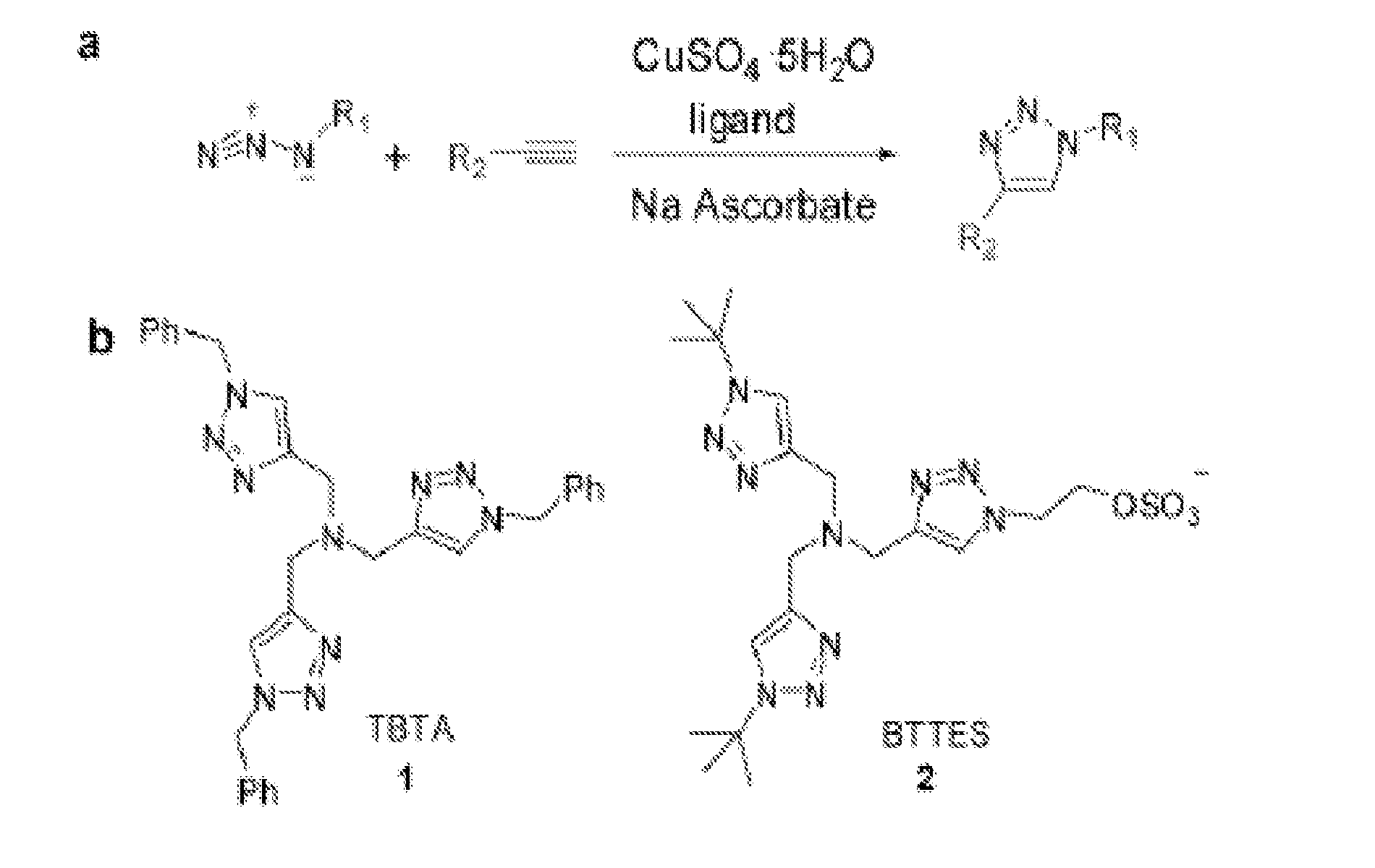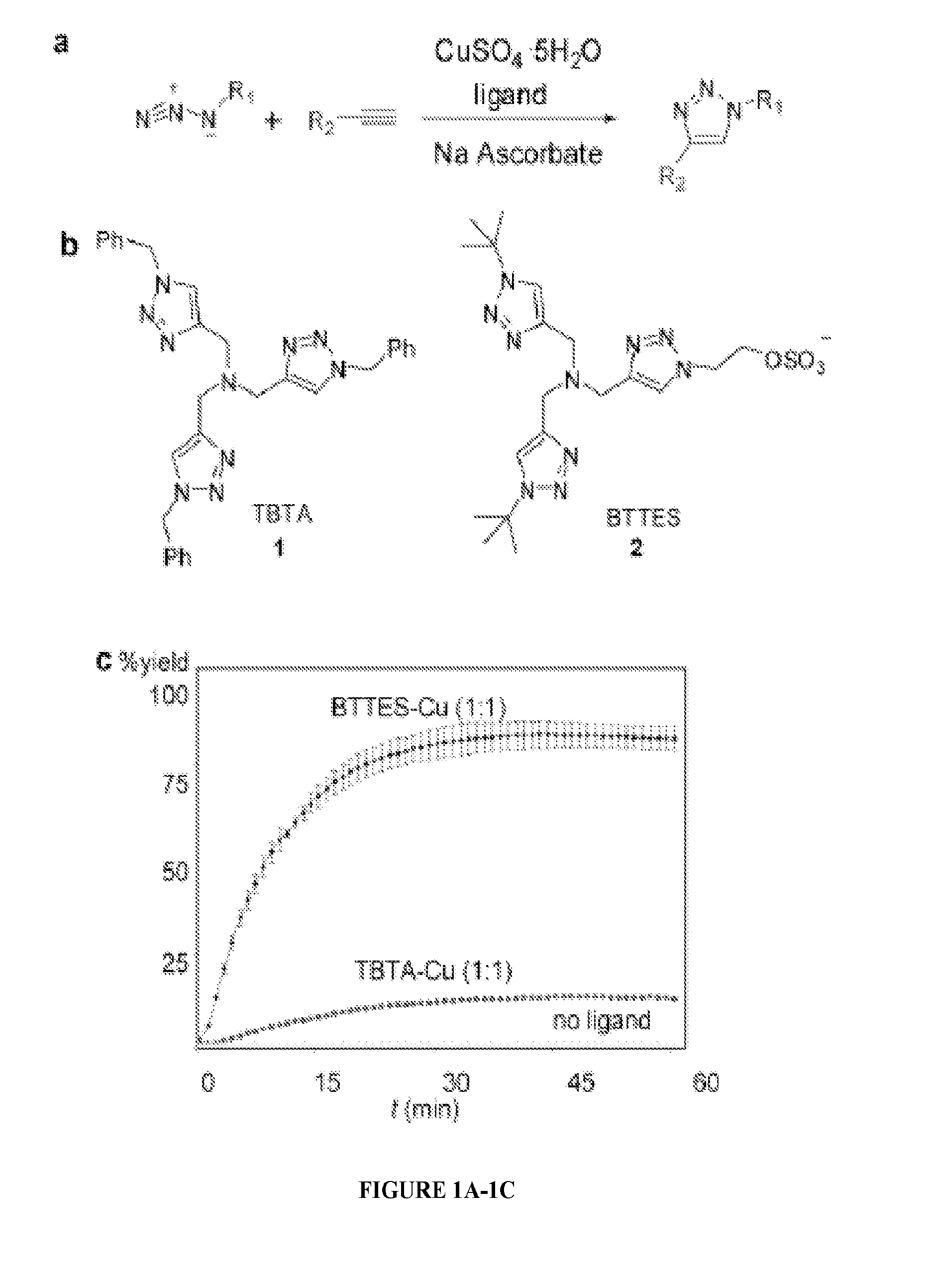Ligands and methods for labeling biomolecules in vivo
a technology of biomolecules and ligands, applied in the field of ligands and methods for labeling and/or imaging biomolecules in vivo, can solve the problems of hampered cuaac use in living systems, inability to label biomolecules via cuaac, etc., and achieve the effect of reducing the reaction
- Summary
- Abstract
- Description
- Claims
- Application Information
AI Technical Summary
Benefits of technology
Problems solved by technology
Method used
Image
Examples
example i
1. Materials and Methods
[0056]All chemical reagents and solvents were obtained from Sigma-Aldrich and Acros and used without further purification unless otherwise noted. Flash chromatography was performed using a Sorbent 60 Å 230- to 400-mesh silica gel. Analytical thin layer chromatography (TLC) was performed on glass-backed Analtech Uniplate silica gel plates, and compounds were visualized by staining with p-anisaldehyde or phosphomolybdic acid or KMnO4 stain. Organic extracts were dried over anhydrous MgSO4 or Na2SO4, and the drying agent was removed by gravity filtration. Unless otherwise specified, all solvents were removed under reduced pressure, using a rotary evaporator. Rhodamine-dextran, Alexa Fluor dye-conjugated azides and alkynes were purchased from Invitrogen. Frosted Microscope Slides and wide-bore Pasteur pipets were purchased from Fisher Scientific and 18×18 mm square cover glasses were purchased from Corning. Melting point (m.p.) was taken on a Melt-Temp (Laborotar...
example ii
Labeling of Live Mammalian Cells
[0097]In the ligand design, sulfation of BTTP is used to generate a negatively charged ligand, BTTPS, to minimize the cellular internalization of the coordinated copper. To evaluate if sulfation confers the ligand the desired property, BTTPS-Cu(I) and BTTP-Cu(I) were compared in live cell labeling experiments. Jurkat cells were metabolically labeled with Ac4ManNAl. The treated cells were reacted with biotin-azide (50 μM) in the presence of BTTPS-Cu(I) or BTTP-Cu(I) for 5-15 min at room temperature (catalyst formulation: [ligand]:[CuSO4]=6:1, [CuSO4]=75 μM). After the reaction was quenched with BCS, the biotinylated cells were incubated with Alexa Fluor 488-streptavidin. The cells were then stained with 7-aminoactinomycin D (7-AAD), a fluorescent molecule with strong affinity for double-stranded DNA, and analyzed by flow cytometry. 7-AAD does not pass through intact membrane, but it readily enters damaged cells with compromised membrane. Therefore, hea...
PUM
 Login to View More
Login to View More Abstract
Description
Claims
Application Information
 Login to View More
Login to View More - R&D
- Intellectual Property
- Life Sciences
- Materials
- Tech Scout
- Unparalleled Data Quality
- Higher Quality Content
- 60% Fewer Hallucinations
Browse by: Latest US Patents, China's latest patents, Technical Efficacy Thesaurus, Application Domain, Technology Topic, Popular Technical Reports.
© 2025 PatSnap. All rights reserved.Legal|Privacy policy|Modern Slavery Act Transparency Statement|Sitemap|About US| Contact US: help@patsnap.com



